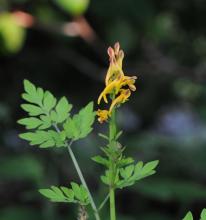I grew this Corydalis from seed. It came as C. panciovulata and it was sent from China. Flora of China does not list this species...not even one with a name that is close (assuming the name was misspelled). I expect it may be biennial but I did let it seed. The plant grew about 45 cm in height so not short at all. It does not have a tuberous root. I'll post it with the remote chance someone might recognize it.
Comments
Re: Unknown Corydalis
Gee Mark, you're a genius! ;D Why didn't I see the 'paniculata'...and I think you are right in the ID. It will be interesting to see if it comes back this year as it is suppose (C. hookeri) to be perennial.
Re: Unknown Corydalis
Gee Mark, you're a genius! ;D Why didn't I see the 'paniculata'...and I think you are right in the ID. It will be interesting to see if it comes back this year as it is suppose (C. hookeri) to be perennial.
Well, I was just guessing. First thing I do in these cases is to jump onto IPNI.ORG, then do a wildcard search on the dubious species name, so I searched on "*" for the genus (to get any genus) and "panciovulata" as the species name, and the search came up empty, telling me the species name was most likely invalid, not only for Corydalis, but for any plant genus at all. Then I start looking for name corruption possibilities... in Google if you type in "panciovulata", it automatically wants to correct it to "paniculata" (Google is the genius here ;D). Back to IPNI, I validate something named C. paniculata exists, then I searched for it on Google and in Flora of China. As I mentioned, I love a good mystery ;)


I love a good mystery. My guess is, the name "panciovulata" is a spelling corruption for "paniculata". There is a Corydalis paniculata in Flora of China, although it is a synonym for C. hookeri.
Corydalis "paniculata" (can't vouch for correctness, since this is a Flickr photo)
http://www.flickr.com/photos/inaturer/485987449/
FOC
Corydalis hookeri (syn: Corydalis paniculata C.Y. Wu & H. Chuang 2008)
China, Nepal, Bhutan, India
http://www.efloras.org/florataxon.aspx?flora_id=2&taxon_id=242314694
Corydalis hookeri - photo
http://www.asianflora.com/Fumariaceae/Corydalis-hookeri.htm
Maybe this is your plant?